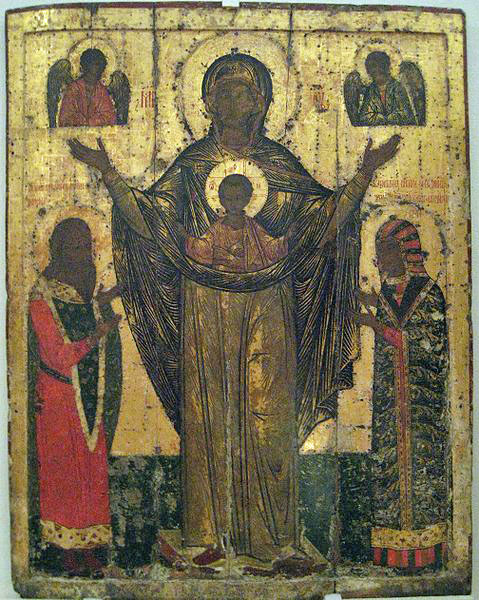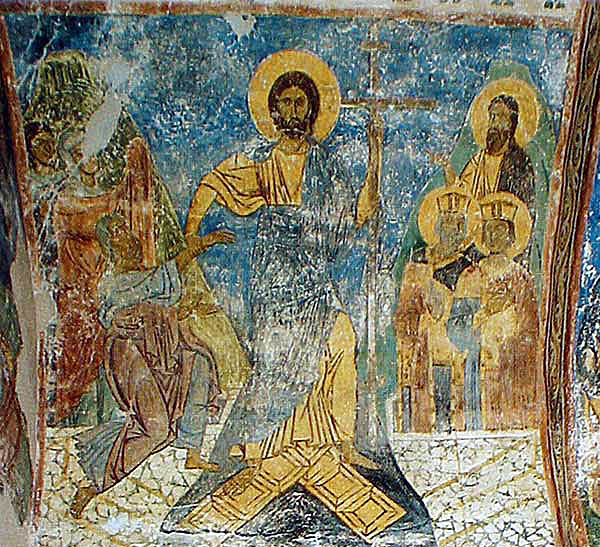
Photo Panoramio
Pskov
Link to Google-Earth file Pskov.kmz
This requires that you have GE on your hard disc.
History of Pskov
Pskov,
which is said to have been founded in 996, was united with Novgorod
to form a bishopric in 992. A republic like Novgorod Pskov rose in
the middle ages to be the emporium of a considerable trade with
Germany and other countries, and it became a member of the Hanseatic
League. During the Mongolian invasions of Russia the town asserted
its independence. It also beat off the attacks of the Teutonic Order,
The Grand Master of the Teutonic Order, failed to capture Pskov in
1502. In 1510 Grand-Prince Vasili III. Ivanovitch at last succeeded
in destroying the independence of the city and incorporated the
republic with the principality of Moscow. In 1570 Tsar Ivan the
Terrible advanced against Pskov, whose inhabitants he suspected of
treason, but he allowed himself to be turned from his plan of
destroying the city by the monk Nicholas Salos, who feigned madness
to effect his end.
Adapted from Karl Baedeker, "Russia",
Leipzig, 1914
The Architecture of Pskov
Pskov
is a world of its own. It flourished on its trade, but never played a
high political role. It is one of the very few cities of the Old Rus
that was never devastated or occupied by the Mongols or Tartars. It
boasts a number of small churches from the 11th to the 17th centuries
that were built by indigenous craftsmen: A veritable Museum of
Russian
architecture sine qua
non.
Pskov's unique style is best seen in these small churches:
single domed buildings with an attached simple bell tower and a
covered porch. Their walls are often picturesquely rough and crooked.
In some frescoes have survived from the 12th cent under later
plaster, now restored (e.g., Cathedral of the Transfiguration).
Pskov Trinity Cathedral and Kreml
1138
Photo Panoramio
The first wooden Trinity Cathedral was built in the tenth century, allegedly under the patronage of Princess Olga, but this seems unlikely as Olga's conversion was personal, and the conversion of Kievan Rus did not occur until 988, almost two decades after her death. Thus, it seems likely the first church dates to the time of Christianization or shortly thereafter. This church was replaced by a stone church in 1138.

Photo Panoramio
The
cathedral was destroyed and rebuilt several times over the centuries,
e.g., in 1367. The current building was built beginning in 1691 and
consecrated in 1699.

Photo
icon-art
Our Lady of Tikhvin with Akathist, 193 × 146 cm, from
the Trinity Cathedral, first half of the 16th cent, Pskov State
Historical, Architectural and Art Museum.
Pskov Cathedral of the Transfiguration
1130

Photo Panoramio
The Cathedral of the Transfiguration in the Mirozhsky
Monastery, Pskov 1130 
The Mirozhsky Icon of the Mother of God Orans, “Virgin
of the Sign” ,attended by the donor-saints Prince Dovmont and
his wife Maria Dmitrievna. Pskov Museum of Art
The
unique frescoes of the Transfiguration Cathedral
12th
centrury

Photo icon-art
Descent into Hell 1130s

Photo
icon-art
Christ before Caiaphas, 1130s

Photo
icon-art
Appearance of Christ to the women visiting his tomb (Easter),
1130s

Photo wikipedia.ru
The Ascension of Christ in the
dome, before 1156
Church
of the Nativity of the Virgin in the Snetogorsky Peter and Paul
Monastery
1311

Photo
pleskovhram.ru
Snetogorsky Monastery above the Reka Velnika (Big River),
1311. At present Snetogorsky Monastery is occupied by nuns.

Photo Saveli Yamshchikov, "Pskov", Aurora,
Leningrad, 1978
Frescoes in the church of the Nativity of the
Virgin, part of a Nativity. The frescoes show Macedonian
influence.1413

Photo Saveli Yamchtchikov, "Pskov", Aurore,
Leningrad, 1978
Frescoes in the church of the Nativity of the
Virgin, part of a Dormition 1413
The
Minor Churches of Pskov
Church of the Archangel Mikhael
1339
- 1696
Church of Archangel Mikhael 1339, repairs and alterations
(1613 and 1696) have changed the original appearance of the church:
chapels and galleries. The tower is 17th cent.
New Ascension Church
1467
– 17th cent
Photo Panoramio
New Ascension Church 1467, rebuilt in the 17th century
Church of St Nicholas on Lake Pskov
1472
Photo Panoramio
Church of St Nicholas on Lake Pskov, 1472 For a detailed
description of the history and architecture of this church see
pskovgrad.ru
St George of Vzvoza
16th
cent
Photo Panoramio
Church of St George of Vzvoza,
Church
of St. Nicholas at Usokhe
1536
Photo Panoramio
Church of St. Nicholas at Usokhe, 1536
Church
of the Assumption of the Theotokos at the Ferry
1521
Photo Panoramio
Church of the Assumption of the Theotokos and bell tower at
the Ferry, 1521
Church
of the Intercession and the Nativity at Proloma
1581
Photo Panoramio
Church of the Intercession and the Nativity at Proloma 1581
Old
Ascension Church
16th
cent
Photo Panoramio
Old Ascension Church, (Staro Vosnecheniya) 16th century
Church
of St. Nicholas in the Market
1676
Photo Panoramio
Church of St. Nicholas in the Market, 1676
The
Castle of Izborsk
East
of Pskov
9th
cent
Photo Panoramio
The earthen walls of Izborsk west of Pskov was the seat of
Rurik's brother Trurov from 862-864 and one of the most formidable
fortresses of medieval Russia.
The
Pechory Monastery
18th
cent 
Photo Panoramio
The Monastery of the Caves or Pskovo-Pechersky Dormition
Monastery (present buildings 18th cent) east of Pskov on today's
Estonian border. View of the precinct from across the wall.

Photo Panoramio